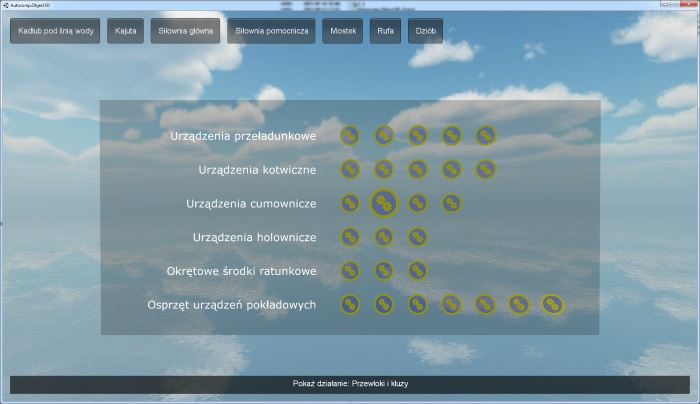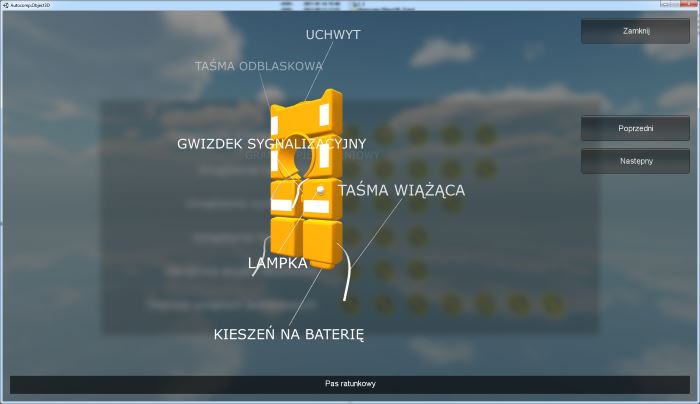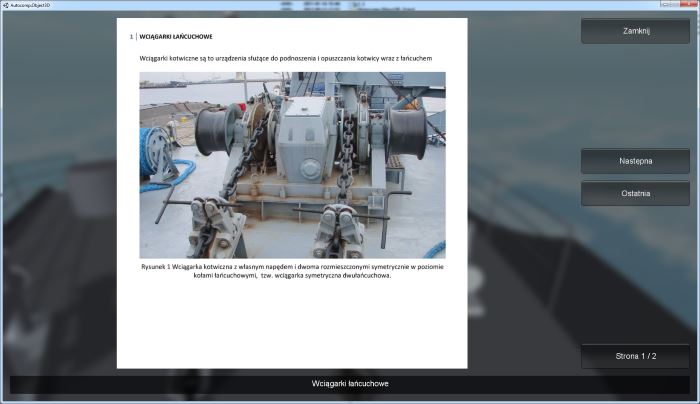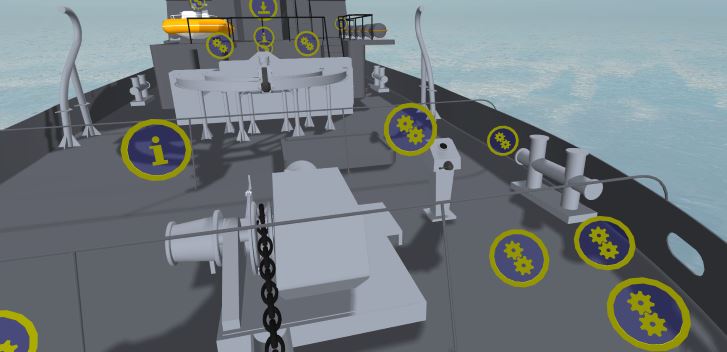Simulator Ship 3D allows to know the construction of the ship and it's used for teachnig Marine knowledge, construction and theory of ship. It is used to train in accordance to with the Convention STCW 78/95 (Standards of Training, Certyfication and Watchkeeping for Seafarers Convention) and also in the training of crews of vessels.
3D steroscopic projection
The simulator uses the innovative on the domestic simulator market 3D stereoscopic projection system. It is based on stereoscopy, namely a technique which enables obtaining the images reproducing the effect of two-eye sight.
This technology is characterised in that the displayed image creates the impression of normal, spatial sight, representing not only the shape and colour of objects (available in classical simulator techniques), but also the spatial shape of objects, their mutual spatial relationships, distance from the observer and the environment depth. In order to re-create this depth, it would be necessary to present a slightly different image to each of the eyes, namely the image the particular eye would see during observation of an actual, spatial object.
In practice, a so called stereocouple is prepared, including two two-dimensional objects representing the environment seen from the perspective of the left and the right eye. Both components of the stereocouple are very similar but differ slightly in the angle of object view and in details of mutual object superposition in the scene. These small differences contain the information about the third dimension. The brain combines these two images into a single three-dimensional spatial image also known as a cyclopic image, since it is perceived as if seen by a single "three-dimensional" eye located at the base of the nose.
Application screen - bridge

Overview
Four individual stations and a single lecture station enable the trainees to be provided with the required knowledge of ship design with presentation of the required information on the basis of which the trainee could identify the indicated equipment or devices and make decisions regarding operation and use of said equipment depending on the accepted task scenario. The specialised software allows tasks to be executed individually by the trainees, or using the computer network, under supervision of the instructor. The stations are fully equipped by the company, depending on the needs, with furniture, handles, accessories, computer with software, computer display, etc.
Individual stations – each of the stations is equipped with a 3D display enabling stereoscopic image to be displayed with a refresh rate of 120 Hz, wireless, stereoscopic 3D goggles enabling correct view of the displayed stereoscopic image (the glasses provide the view of only correct frames for each of the observer eyes), an infrared transmitter controlling operation of the 3D goggles, a glove with sensors allowing interaction with simulator software.
Lecture stations – they enable the presentation of system operation to several trainees simultaneously. It is equipped with a 3D projector displaying stereoscopic image with a refresh rate of 120 Hz, 12 wireless 3D stereoscopic goggles enabling correct view of the displayed stereoscopic image, a single infrared transmitter controlling operation of all 3D glasses, a glove with sensors allowing interaction with simulator software.
Features
The simulator uses the method of alternating image display, for the right and left eye respectively. The presented scene is observed through the active goggles equipped with shutters synchronised with the projection system. Thus, each eye receives different information about the image (the left eye sees only the image generated by the camera shifted to the left, whilst the right eye - from the camera shifted to the right), and the brain reconstructs a spatial scene from the images.
Moving around within the scene and controlling exercise execution is possible thanks to the gestures made using the 3D glove. Thanks to the 3D glove, software operation becomes even more convenient and more intuitive than using traditional interaction levels (mouse, keyboard). The glove is controlled using a range of gestures, recognisable by the software.
The Three-dimensional Ship Design Simulator is provided with options of equipment and devices identification related to all ship departments, with particular focus on on-board instruments. The simulator allows, especially, the following tasks to be executed:
- training and improvement of skills related to identification of on-board equipment and their accessories, loading and unloading equipment, anchoring equipment, hawser equipment, towing equipment and on-board emergency and rescue equipment.
- virtual operation of on-board equipment and their accessories, loading and unloading equipment, anchoring equipment, hawser equipment, towing equipment and on-board emergency and rescue equipment based on the virtual reality technology.
- trainee testing according to taxonomy accepted in didactics, taking place on the basis of thematic visualisation scenarios.
Application screen - menu

Application screen - object details

Application screen - deck - object preview

Application screen - lift





